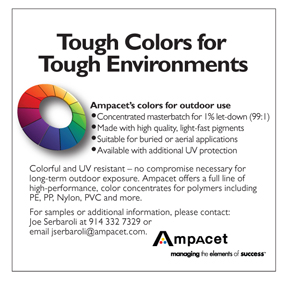Additives Add Value to Thermoforming
Presenters at SPE’s recent Thermoforming Conference showed that this statement is truer than ever
Previous Article Next Article
By Nancy D. Lamontagne
Additives Add Value to Thermoforming
Presenters at SPE’s recent Thermoforming Conference showed that this statement is truer than ever
Previous Article Next Article
By Nancy D. Lamontagne
Additives Add Value to Thermoforming
Presenters at SPE’s recent Thermoforming Conference showed that this statement is truer than ever
Previous Article Next Article
By Nancy D. Lamontagne

Minerals such as calcium carbonate can add rigidity and stiffness to thermoformed products while also reducing the energy required to make the final product (photo courtesy of Heritage Plastics).

Slip/antiblock masterbatches are an alternative to traditional silicone coatings, and are often used for thermoformed food packaging and cups (images courtesy of Sukano Polymers).

Slip/antiblock masterbatches are an alternative to traditional silicone coatings, and are often used for thermoformed food packaging and cups (images courtesy of Sukano Polymers).

Slip/antiblock masterbatches are an alternative to traditional silicone coatings, and are often used for thermoformed food packaging and cups (images courtesy of Sukano Polymers).

Slip/antiblock masterbatches can also increase food release from thermoformed cooking containers, such as lasagna trays that go from the freezer to the oven (image courtesy of Sukano Polymers).

Industry experts gathered for the 24th Annual SPE Thermoforming Division’s Thermoforming Conference, from August 31 to September 2 in Atlanta, Georgia, USA. The conference serves as an important place to share ideas, see thermoforming innovations, and to network with colleagues.
During the technical sessions, additives emerged as a hot topic. Industry leaders spoke about how the right additives can add new characteristics into thermoformed products and also improve product sustainability.
Minerals Offer More than Cost Savings
Holly Hansen, vice president of technical services at Heritage Plastics Inc. in Atlanta, presented on new developments in the use of minerals in rigid plastics. Heritage Plastics specializes in offering highly filled mineral concentrates for a variety of plastic resins and applications. She explained that calcium carbonate (CaCO3) garners the most interest because of its cost-saving opportunities.
“CaCO3 is a well-known reinforcing agent, so it can go into resin systems, and, depending on what targeted level is being selected, it will add rigidity and stiffness and help with impact performance,” Hansen said. “These characteristics make it well-suited for thermoformed food service items, and it also brings a lot of benefits to the industrial side of thermoforming.”
Hansen explained that significant developments in mineral technology over the past decade have allowed Heritage Plastics to offer mineral concentrates containing CaCO3 that is cleaner, has a tighter particle size distribution, and has improved surface treatments. “Better product on the CaCO3 side allows higher levels to go into a given part while still, at a minimum, maintaining performance, and in many cases improving part stiffness and rigidity,” she said.
“We select the minerals based on their performance and what they bring to the table, and then we combine [them] with a resin carrier. We’ve gotten a lot smarter in our resin selection as well. The ultimate end product is a pellet that can be easily incorporated into a resin system using existing feeding equipment.”
CaCO3 brings additional benefits to thermoforming. Ithas a much higher thermal conductivity than the resin, so in the extruder the mineral lets heat into the matrix more efficiently and uniformly. Italso helps with cooling the matrix. For thermoforming, these properties translate into faster cycle times.
“Thermoforming has been a good growth market for us,” Hansen said. “It is driven some by the cost-saving opportunity and some by the demand for food service items and packaging. The growth has been over and above just people trying to save money. It is serving a key functional role.” For example, one manufacturer turned to CaCO3 to create a plastic container that could withstand microwave temperatures that straight polypropylene wouldn’t withstand.
CaCO3 also comes with environmental advantages. The mineral is responsibly produced using environmentally friendly practices. Its production emits lower carbon emissions than the standard resins it replaces, and using CaCO3 also lowers the energy required to produce the final part.
Heritage Plastics contracted outside agencies to perform life-cycle analyses comparing calcium carbonate’s environmental footprint to that of petrochemical-based resins. Hansen said that clients appreciate that the numbers have been validated, and that several companies tell customers that they’ve replaced a certain amount of the resin with a natural mineral because of the environmental advantages. During her talk, Hansen said that replacing 40% of the polypropylene in a thermoformed food container could reduce the product’s carbon footprint by 16% and energy use by 11%, and that replacing 20% could reduce the carbon footprint by 8% and energy use by 7%.
During the presentation, Hansen went over some things to keep in mind when choosing a mineral concentrate. She said that it’s absolutely key to discuss the purity of the mineral with the supplier and to select a mineral that has proven purity thresholds. Part density is also an important consideration.
“Density is a tricky formula,” she said. “If people plan to use minerals, they need to keep their part weights the same. Because density is inversely related to volume, some volume will be lost as the density increases. This requires slight downgauging to keep the part weight the same. Since the mineral brings a reinforcing benefit, the resulting part typically has equivalent performance to a resin-only system.”
Enhancing Properties with Masterbatches
Meanwhile at the conference, John Price, a technology and development engineer at Sukano Polymers Corp., gave a presentation on functional additives and new advances for sheet extrusion thermoforming. Sukano Polymers focuses primarily on specialty masterbatches, including products for improving surface appearance and UV properties as well as melt enhancers and high-loading/dispersion whites. Price discussed how masterbatch additives can enhance the properties of many types of resins and also add value to sustainable products such as biopolymers and recycled PET.
“Part of our philosophy is different from some masterbatch suppliers in that we try to match the customer’s polymer with the carrier resin that we supply them,” explained Price. “This reduces the impact that the additive will have on their processing and means they don’t have to do any type of special handling to add it to their system.” Sukano Polymers starts with a standard palette that can be quickly and readily turned into a new formulation. Within a few weeks the company can provide the customer with a product that’s ready to run.
The first part of Price’s conference talk focused on slip/antiblock masterbatches as an alternative to traditional silicone coatings, which pose some challenges. Silicone coatings require auxiliary equipment to add the coating, offer very little control of how much silicone is added to the product, and the coating process is often inconsistent.
There are also concerns about how silicone affects recycling. Sukano Polymers is collaborating with the National Association for PET Container Resources to better understand how silicone that gets into the recycling stream affects processing or impacts haze or other characteristics of thermoformed parts made of recycled PET.
Price explained that the high loading of additives in slip/antiblock masterbatches offer a very consistent and controlled system. The antiblock part of the masterbatch uses solid particles to reduce surface contact, while a slip agent creates a slippery film on the contact surface. Since slip/antiblock masterbatches don’t contain silicone, they may also be better able to maintain performance in recycled PET products.
Slip/antiblock masterbatches are currently used for thermoformed food packaging and cups, as well as folded boxes for packaging devices, toys, and cosmetics. They are also finding new applications in the food industry for increasing food release from thermoformed cooking containers, such as lasagna trays that go from the freezer to the oven.
Price pointed out that masterbatches are not a one-fit-all type product. “Selecting the best solution requires a good understanding of the customer’s feeding capabilities, the kind of product and depth of draw, the construction of the material, whether an in-line or off-line thermoforming process is used, [and] any post-treatments,” he said. “We can help customers choose the right slip/antiblock masterbatch because we understand the processing equipment and conditions.”
Price’s presentation also covered how additive masterbatches can be used to optimize sustainable materials such as biopolymers and recycled PET. For example, adding impact modifiers in the outside layers of the sheet allows a higher percentage of recycled PET to be used in a product by preventing some of the brittleness that would normally result from higher recycled content. Also, color enhancers can be used to neutralize the green/yellow color of recycled PET.
The company offers a full array of additive masterbatches for PLA and other biopolymers. Price says that the additives can improve biopolymer properties, allowing them to be viable replacements for PET or PETG type polymers.
